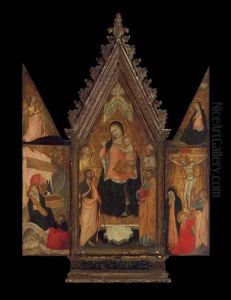Niccolo Di Tommaso Paintings
Niccolò di Tommaso was an Italian painter active during the 14th century, specifically within the period art historians refer to as the late Gothic or, in Italian context, the Trecento. Little is known about his early life or training. His birth year is estimated to be around 1324, but the exact date and place of his birth are not documented. Niccolò's work is associated with the Florentine school, and he is considered to have been influenced by the likes of Giotto and his followers, who were pivotal in the development of Italian Renaissance art.
Niccolò di Tommaso’s career is traced through a handful of surviving paintings and documented commissions. He is known to have been active from the 1350s until his death in 1376. His work includes altarpieces and frescoes, which often featured religious subjects, a common theme for the period. One of his notable works is the 'Life of St. John the Baptist,' found in the Florence Baptistery. His style is characterized by the use of vivid colors, a keen attention to detail, and a gentle narrative approach to the scenes he depicted.
Despite Niccolò's clear contributions to the development of Florentine painting, his reputation does not equal that of his contemporaries like Giotto or later figures such as Masaccio, who are celebrated for their roles in the early Renaissance. Nevertheless, Niccolò di Tommaso's work provides valuable insight into the transitional phase of Italian art from medieval conventions towards the Renaissance's focus on naturalism, perspective, and human emotion. After his death in 1376, his influence persisted in the form of students and followers who continued to disseminate his style and techniques.






